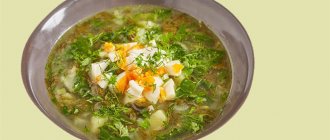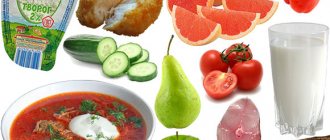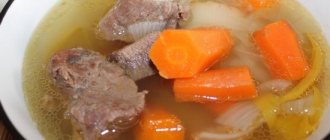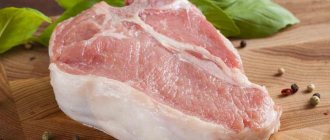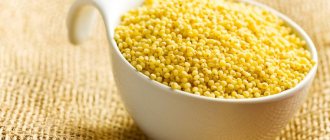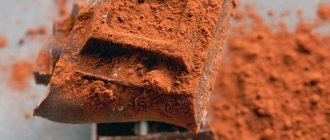To be in good physical and psychological shape, you need to play sports, observing a certain diet, in which it is important to take into account the amount of vitamins, minerals and calories entering the body from food. It is very important to draw up a menu for the day, calculating it so that the amount of substances supplied corresponds to the norm, and in some cases exceeds it. Therefore, Food-and-Food continues a series of articles about the calorie content and beneficial properties of foods to facilitate the process of creating your diet for every day. In this article you can find out how many calories are in borscht with pork.
Pork borscht: recipe
Borscht with pork, the recipe for which we publish, is prepared from the following products:
- Pork – 300 g
- Beets - 2 pcs.
- Cabbage - 750 g
- Carrots - 2 pcs.
- Potatoes - 4 pcs.
- Tomato paste - 2 tbsp.
- Onions - 3 pcs.
- Lemon juice - 1 tbsp.
- Vegetable oil – 100 ml
- Parsley - 1 bunch
- Cloves - 3 pcs.
- Garlic – 2 cloves
- Black pepper - 0.5 tsp.
- Salt - to taste
- Bay leaf - 1 pc.
Some ingredients were not previously added to traditional pork borscht, but over time the recipe for the dish has undergone changes. For example, adding to borscht with pork, the recipe
step by step which is presented below, lemon juice, we will achieve a more saturated and bright color.
Pork borscht: step-by-step recipe
1) First of all, wash and cut the meat. Since the calorie content of borscht with pork
directly depends on the part of the carcass chosen for cooking; we use lean ribs.
2) To prepare borscht with pork according to the recipe, peel the onion and garlic, wash the parsley, and cut the carrots into large rings.
3) Stick the cloves into the onion and, together with half a bunch of parsley, pepper, bay leaf, garlic, carrots and meat, place them in a four-liter saucepan.
4) Pour water over the vegetables and ribs, bring to a boil and cook over low heat for about 2 hours, periodically skimming off the resulting foam. An hour after the water boils, add salt to the pork borscht broth.
5) While the broth is preparing, let’s make a dressing that is added to the borscht with pork according to the recipe:
- Cut the onion into cubes.
- Grate the beets and carrots for the pork borscht on a coarse grater.
- Fry the onion in a frying pan in heated sunflower oil.
- After a few minutes, add carrots and beets to it and simmer everything together until soft (about 20 minutes) under a closed lid.
- Then add tomato paste and lemon juice to the vegetables, simmer for another 5 minutes.
6) Remove the herbs, vegetables and pork from the finished broth, separate the boiled meat from the bones.
7) Cut the peeled potatoes into cubes, and shred the cabbage into borscht with pork according to the recipe.
 Bring the broth to a boil and add potatoes, cabbage and meat into it.
Bring the broth to a boil and add potatoes, cabbage and meat into it.
9) Cook vegetables for 20 minutes.
10) After making sure that the potatoes are cooked, put the dressing, salt, pepper and finely chopped parsley into the pan.
11) Bring the pork borscht to a boil, remove from heat and let simmer for at least 10 minutes. The finished dish is served with sour cream, the fat content of which directly determines the final calorie content of borscht with pork.
- Pork (300 g) – 963 kcal
- Water (2.5 l) - 0 kcal
- Cabbage (750 g) - 202.5 kcal
- Carrots (150 g) – 48 kcal
- Potatoes (400 g) – 320 kcal
- Onions (225 g) – 92.25 kcal
- Beetroot (250 g) – 100 kcal
- Lemon (1 pc.) – 8 kcal
- Sunflower oil (100 ml) – 899 kcal
- Black pepper (0.5 tsp) – 8.79 kcal
- Parsley (15 g) – 7.05 kcal
- Tomato paste (2 tbsp) - 55.2 kcal.
Calorie content of borscht with pork (100 g serving): 53 kcal.
Alternative recipe for borscht with pork
SUBSCRIBE TO ORIGINAL RECIPES AND NUTRITION TIPS
Borscht is a truly universal dish: thick, rich, it will warm you up and give you strength during the cold season; light, green - will refresh and quickly nourish you in the heat. And although this dish has been known since ancient times, no two housewives would cook the same borscht.
However, even for the same housewife, on different days it turns out to be different in taste: when the master cook adds fresh tomatoes instead of tomato paste, when she chops bell pepper into the frying dish, when she pours sauerkraut into a saucepan instead of fresh cabbage... That’s why it’s difficult to calculate the calorie content of borscht. However, some numbers can still be derived.
Green or cooked with a lot of beets, lean or with meat broth - any borscht will bring health benefits.
This is a wonderful dish:
- being balanced in composition, it contains almost all the proteins, fats, carbohydrates, vitamins and minerals that a person needs;
- gently envelops the inner walls of the stomach and intestines, helping to cope with chronic gastrointestinal diseases;
- satiating well even with a small portion, it saves you from overeating;
- improves metabolism and promotes the rapid breakdown of carbohydrates and fats entering the body. This process is accompanied by the release of heat. This is why after a plate of borscht it becomes hot;
- Due to the high fiber content in vegetables, it gently cleanses the intestines, removing toxins and heavy metals.
How long to cook pork for borscht
Step 1.
We start cooking this wonderful dish by preparing the broth. This time it's pork broth. Place the washed fresh meat in a saucepan, pour in water, add salt and bring to a boil.
At the same time, we constantly remove the foam that appears (if it is not removed, the broth will turn out cloudy). When the pork is already simmering over low heat, throw a couple of bay leaves and a dozen black peppercorns into the pan. In our opinion, this gives the broth a special flavor. But how long should you cook pork for borscht? It all depends on the size of the piece used; we recommend cooking in small pieces. On average, pork is cooked for about an hour, checking for doneness by piercing the meat with a fork. If the pork is completely cooked, clear juice will ooze from the fibers.
When the meat is ready, remove it from the pan and leave to cool.
Step 2.
Pour chopped or grated beets into the boiling broth.
Step 3.
When the beets boil for a few minutes, I add some chopped potatoes to it.
Step 4.
Next, add a third of the chopped fresh onion to the pan.
Step 5.
While the beets and potatoes are boiling, prepare the tomato dressing for the borscht. Pour the remaining chopped onion into a frying pan heated with sunflower oil and fry until golden brown (do not fry too much, it will be tasteless). Here we also add carrots, cut into strips and sweet bell pepper.
Step 6.
Dilute the tomato paste with water and add it to the frying pan. Now let the dressing cook over low heat for about 7 minutes.
Step 7
Pour the cabbage cut into thin strips into a saucepan where the potatoes and beets are already well cooked.
Step 8
Next we lay out the pork, cut into small pieces.
Step 9
After boiling, add the prepared tomato dressing.
Before finishing cooking, add a garlic clove cut into thin slices, a few small cloves of celery and pieces of fresh tomato to the borscht with pork. This will give the borscht a subtle, refined aroma.
Step 10
When the pork borscht is ready, test for salt and, with the heat off, add the greens to the pan.
But there are a great many recipes for this dish, and each of them is good in its own way. Yes, pork borscht
, to which this publication is dedicated, is in no way inferior to a dish with beef and will appeal to lovers of fattier meat. In addition, the calorie content of borscht with pork prepared according to our recipe is no more than that of a dish with chicken or beef.
Ideal borscht: studying the composition...
The composition of the dish can indeed include a variety of ingredients, but the basic set is unchanged: potatoes, onions, carrots, beets, tomatoes, white cabbage, greens. From there, everything is limited only by the housewife’s imagination and the selection of products available in the refrigerator.
You can make the borscht more rich by adding boiled beans or fresh green peas to it, acidify the dish with lemon juice or sauerkraut instead of fresh cabbage, cook it with broth from whatever meat you find in the freezer: with chicken, pork, and It’s good with beef, and veal, and rabbit. Bay leaf, allspice and celery root will add flavor to your dish, and a finely chopped clove of garlic will add a piquant flavor.
Green borscht is most often seasonal. It is prepared in the spring with the appearance of the first fresh herbs: wild garlic, sorrel, lettuce. However, nothing prevents you from having a real vitamin holiday in winter using frozen greens. As a rule, beets are not added to this dish and often do without meat at all - finely chopped boiled chicken eggs serve as a substitute.
...and determine the calorie content
Based on the composition of the dish, you can determine its calorie content.
For example, 100 grams of lean borscht cooked in vegetable broth contains only 30 kcal, so those who are uncompromisingly struggling with excess weight can safely include this dish in their diet. A little more - about 37 kcal per 100 grams - contains lean green borscht.
This is explained by the fact that the ingredients of green borscht include chicken eggs and sour cream, which are very high-calorie foods. However, be careful: the same vitamin borscht, cooked in a rich bone broth with meat, will add as much as 187 kcal per 100 grams of product!
But the calorie content of red borscht in meat broth depends on what type of meat was used. For example, the calorie content of borscht with beef will be 87 kcal per 100 grams of product.
The calorie content of borscht with chicken may vary depending on the form in which you cook the bird. Only 34 kcal per 100 grams of dish - provided that the skin is removed from the chicken, and as much as 50 kcal per 100 grams of the first course cooked with chicken with the skin. Nevertheless, chicken meat continues to be one of the most dietary, and therefore often ends up on the plate.
You need to be most careful with pork. Pork meat is usually fatty, which is why the food cooked with it is not at all light - 164 kcal per 100 grams of product.
Therefore, if you adhere to a strict diet - due to illness or to lose weight - it is better to avoid borscht with pork. A dish with pork will successfully replace its counterpart with beef or chicken.
Borscht with chicken: what is the calorie content of this dish?
It is believed that chicken borscht is not only one of the lowest calorie versions of this dish, but is also considered traditional for some regions.
Chicken borscht contains about 45 calories per 100 grams of finished product.
It is worth noting that sometimes this dish is prepared not from chicken meat, but from rooster meat, which makes the broth fattier and richer , but in general the nutritional value of this food remains moderate, so this food is great for those who:
- watches his figure;
- adheres to healthy eating rules;
- prone to eating low-fat foods;
- wants to normalize the functioning of the gastrointestinal tract and maintain the body’s strength.
Reducing the calorie content of borscht: a note for the housewife
If you really love this wonderful dish and are not at all ready to give it up, but you also want to maintain a slim figure, remember these simple tricks:
- fry vegetables in a minimum amount of vegetable oil, and if you have a non-stick frying pan, avoid oil altogether;
- cook the broth with meat, and not with a meat bone: this way you are guaranteed to save yourself from extra calories;
- borscht cooked with fresh cabbage will be much lower in calories than one cooked with sauerkraut;
- the fewer potatoes in the dish, the better for your figure;
- instead of mayonnaise as a dressing, you can use low-fat sour cream or abandon it altogether;
- It is better to serve a plate of aromatic dish with black or gray bread, but not white bread: rye baked goods are better suited to taste, and they contain fewer calories than wheat baked goods.
Perhaps almost everyone loves borscht - in any case, most of us will not refuse to try a delicious, aromatic soup with beets. The excellent taste of this dish is not the only thing worth loving about it - after all, borscht is also very healthy. This soup contains ingredients that are healthy for the body - beets, onions, carrots, garlic, cabbage, potatoes and meat. All these products are very useful. When preparing borscht, you can use either fresh or sauerkraut, but it is advisable to use meat that is not too fatty. As a snack for borscht, lard, bread with garlic or garlic dumplings, onions, herbs, croutons, etc. are used. Ukrainian borscht is always served with sour cream.
The calorie content of borscht is influenced by the calorie content of the meat that was used to prepare borscht - pork is the fattest and highest in calories, so the calorie content of borscht with pork will be high, but if you cook borscht with lean beef, then the calorie content of borscht will be much lower. Vegetarian borscht has the lowest calorie content - only 25-30 calories per 100 g, that is, less than 80 calories per cup. The calorie content of borscht with sauerkraut is higher than the calorie content of borscht, in the preparation of which fresh cabbage was used. The calorie content of Ukrainian borscht is about 90-100 kcal per 100 g, the calorie content of green borscht (on the bone, with sorrel, herbs) is 168 kcal per 100 g.
If you love borscht but are counting calories, you can reduce the calories in borscht in several ways. Prepare borscht using lean, boneless meat. This way you will reduce the calorie content of the borscht by reducing the calorie content of the broth in which the borscht is cooked. It is best to cook borscht in chicken or beef broth - it is lower in calories than pork or lamb. When preparing frying for borscht, it is traditional to fry onions and carrots in oil or lard. To reduce the calorie content of borscht, you can sauté them in a frying pan with water. The use of beans instead of potatoes also reduces the calorie content of borscht. There are few calories in borscht with beet tops instead of beets themselves (69 kcal per 100 g).
The calorie content of borscht will be lower if you season it not with mayonnaise, but with low-fat sour cream. It is better to serve bread with borscht not from premium wheat, but from rye or Borodino bread - it not only contains fewer calories, but also goes better with borscht.
Features of preparing borscht from various parts of meat
Traditional Ukrainian borscht is made from fatty meat - pork or beef, but such a broth will be very heavy, so it is not recommended for people with a weak or sick stomach, the elderly or children.
If you are interested in making pork borscht and have already gone to the store, but are confused by the wide range of meat, then feel free to take any piece that catches your fancy.
The broth cooked on the bone turns out to be very rich, so most often ribs are used for borscht. You can also buy tenderloin, shank, shoulder or brisket.
There are recipes in which the broth is specially prepared using only bones, and not for enhanced savings, but to obtain aromatic and rich borscht, which will be less fatty than a similar one made with meat.
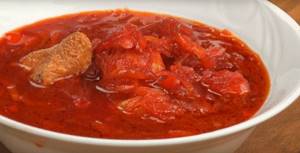
Borscht is such an intuitive dish that every cook and housewife has their own recipe. It is prepared with different types of meat, including smoked, with the addition of various ingredients - sauerkraut, mushrooms, sorrel. Therefore, feel free to experiment, the main condition is to do everything with love, and then it will always turn out delicious. Bon appetit and good luck!
Benefits and calorie content of borscht
Despite how many calories there are in borscht, borscht can and should even be eaten by everyone, even those who are on a diet. It is nourishing and healthy; a plate of borscht will completely replace a full meal, both in terms of satiety and the content of useful and nutritious substances. Borscht contains fats, proteins, carbohydrates (both simple and complex carbohydrates), dietary fiber, important amino acids, vitamins and minerals. Borscht contains vitamin A, a well-known antioxidant, which has a positive effect on vision, as well as the condition of the skin and all body tissues. Vitamin PP improves metabolism, participates in energy metabolism, helping the body release energy from fats and carbohydrates. It also lowers blood cholesterol and regulates blood sugar. Vitamin C is an effective immunomodulator; it strengthens our body’s defenses and helps it resist various diseases, especially colds and viruses. Vitamin D strengthens bones, joints, and also has a positive effect on the nervous system. Vitamin E is an antioxidant that preserves our youth and beauty and prevents the formation of cancerous tumors.
B vitamins contained in borscht improve metabolism and help the body effectively convert dietary fats and carbohydrates into energy. They are involved not only in energy metabolism, but also in the synthesis of hormones and enzymes, as well as in cell production. Their positive effect on the nervous system is very strong - they strengthen it, stabilize its functioning, improve memory, attention, stimulate brain activity, tone the nervous system, in addition they relieve stress, fight depression, correct sleep disorders, relieve anxiety, help to win fatigue and cope with nervous fatigue. B vitamins are not only effective antidepressants, they are also an effective preventative against the development of mental illness. They increase performance, improve mood and even lower the pain threshold. In addition, B vitamins have a positive effect on muscle function, including the heart, have a general strengthening effect on the body, increase immunity, and enhance the body’s regenerative abilities. B vitamins, due to their antioxidant properties, slow down aging and effectively prevent cancer; in addition, they have a positive effect on the condition of the skin, nails, and hair.
Borscht is rich not only in vitamins, but also in microelements - such as:
- phosphorus and calcium, which strengthen bones;
- fluoride, which strengthens tooth enamel;
- iron, which prevents anemia; magnesium, which is part of the cells of the nervous tissue;
- sodium, which helps maintain water-salt balance;
- potassium, which improves the functioning of all muscles and removes excess water, salt and toxins from the body;
- zinc and copper, which improve the condition of skin, nails and hair;
- iodine, necessary for the proper functioning of the thyroid gland;
- manganese, necessary for the production of hormones and enzymes and for the stable functioning of the nervous system;
- chlorine, sulfur, aluminum, molybdenum and other important trace elements.
Borscht increases metabolism and promotes intensive breakdown of carbohydrates and fats - that’s why immediately after you eat borscht you feel hot. It fills you with energy, removes toxins from the body, improves digestion, and has a beneficial effect on muscle function and the condition of the cardiovascular system. Borscht improves your performance, stimulates brain function, relieves fatigue and tones. Borscht also increases the production of red blood cells - erythrocytes, which improves blood quality.
Diet borscht recipe
The calorie content of this borscht is very small, but its satiety, taste and content of nutrients are quite high. To prepare you will need:
- lean beef – 300 g;
- 2 potatoes;
- 1 carrot;
- 1 onion;
- 1 medium-sized beetroot;
- 2 cloves of garlic;
- parsley – 30 g (small bunch);
- white cabbage – 100 g;
- 1 tomato
- salt, black pepper - to taste.
First prepare the beef broth. Strain it. In a frying pan in a small amount of water without adding oil, simmer the chopped carrots, tomatoes, onions and garlic for 10 minutes, then add the beets, cut into small cubes and simmer for another 20 minutes. While the vegetables are stewing, finely chop the cabbage. Then transfer the vegetables to the broth, let it boil and add the cabbage. When the broth boils, let it simmer for 5-7 minutes and add the potatoes cut into small cubes into the borscht. At the end of cooking the borscht, add salt and pepper and remove from the heat. Before serving, sprinkle with chopped herbs.
The calorie content of borscht prepared according to this recipe is 87 kcal per 100 g (or about 190 kcal in a standard serving).
Popular articles Read more articles
02.12.2013
We all walk a lot during the day. Even if we have a sedentary lifestyle, we still walk - after all, we...
606439 65 More details
Calorie content of borscht:
50 kcal* *average value per 100 grams, depends on the composition of ingredients and method of preparation
A healthy diet is not complete without hot first courses. When choosing between soups, broths and borscht, it is important to pay attention to the energy value of the dishes.
Daily intake of borscht
How much borscht can you eat every day? The exact amount depends on the person's needs and lifestyle. This dish contains most of the valuable vitamins and micronutrients. Therefore, if you wish, you can only eat borscht.
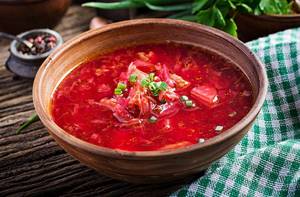
Photo source: shutterstock.com
But here you need to take into account that people employed in heavy production require 4000-5000 kcal per day. If you lead a sedentary lifestyle, then the number of required kilocalories drops to 2500.
Knowing the energy value of a particular type of dish, it will not be difficult to independently calculate the daily intake. For example, if the average calorie content of beef borscht is about 100 kcal per 100 grams, then you can eat a lot of it every day.
Borscht - nutritional value and calorie content of ingredients
Borscht is a hearty, perfectly balanced dish. It contains all the microelements a person needs: fats, proteins, carbohydrates, vitamins, minerals. A large amount of fiber helps eliminate toxins, nitrates, heavy metals, and radionuclides from the body.
With regular consumption of borscht, immunity increases and the functioning of all organs improves.
The classic recipe includes meat, cabbage, potatoes, beets, carrots, onions, and tomatoes. In some regions, beans are added, fresh cabbage is replaced with sour cabbage, and so on. There are as many cooking methods as there are housewives. Well, the final touch is to put a spoonful of thick sour cream in the bowl. The result is a complete, nutritious dish that has been highly valued for many centuries.
How many calories are in different types of borscht (chicken, beef, pork)
People who are concerned about their figure always pay attention to the calorie content of their dishes. As for vegetable soup, this indicator depends primarily on the broth it is prepared with. For example, the calorie content of beef bone broth is only 28 kcal per 100 ml. You can see the table in detail in our publication.
This vegetable soup cooked with pork is considered the most delicious, but also the most high-calorie (~50 kcal). And if during the cooking process sauerkraut is added to the broth instead of fresh, then this figure almost doubles.
A spoonful of sour cream bought at the market adds 90 kcal to the dish. If you purchase a lactic acid product in a store, this figure increases by only 35 units.
Beef borscht is considered dietary (~30 kcal). It has little cholesterol, but a lot of amino acids and vitamin B. Regarding chicken, this vegetable soup is especially recommended for those who are trying to lose weight, since its calorie content is relatively low (~45 kcal). At the same time, it strengthens the body well, which makes it an almost irreplaceable dish for people suffering from any diseases.
Harm and contraindications
Borscht contains many components, each of which may have harmful properties, depending on the individual susceptibility of the body.
All ingredients in borscht are boiled and contain more beneficial properties, but if overused, the dish can be harmful:
- For example, borscht is not recommended for consumption in cases of severe forms of gastritis due to the acidity of cabbage, onions and garlic.
- Beets can harm people suffering from severe forms of cardiovascular disease.
- Vegetable components in borscht can cause allergies in people who are intolerant to certain types of foods, such as onions, cabbage or carrots.
- When cooked separately, vegetables in borscht release heavy metal salts, which can be harmful to the body.
- Tuberous vegetables often contain the most nitrates from fertilizers and when cooked they end up in the broth.
- Borscht broth can harm tooth enamel and is contraindicated for people suffering from caries or gum disease.
How many calories are in one bowl of borscht?
When calculating the calorie content of vegetable soup, you should take into account its ingredients and method of preparation. First, you should calculate this indicator for one hundred grams of the dish, then increase it according to the portion. That is, when you prepared a recipe with pork, beets, carrots, potatoes, cabbage, then one hundred grams of soup will contain approximately 60 kcal. Moreover, if one serving is three hundred grams, then the plate will contain 180 kcal, with sour cream – 270 kcal.
There is probably no person who does not love hearty, rich borscht. The special thing about this dish is that you can add any ingredients to it to suit your taste, and it will always be very appetizing.
To be in good physical and psychological shape, you need to play sports, observing a certain diet, in which it is important to take into account the amount of vitamins, minerals and calories entering the body from food. It is very important to draw up a menu for the day, calculating it so that the amount of substances supplied corresponds to the norm, and in some cases exceeds it. Therefore, Food-and-Food continues a series of articles about the calorie content and beneficial properties of foods to facilitate the process of creating your diet for every day. In this article you can find out how many calories are in borscht with pork.
Borscht in a slow cooker
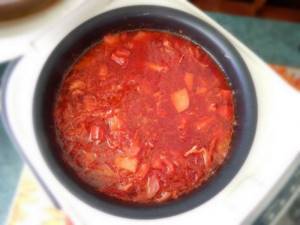
Many people mistakenly believe that a multicooker greatly simplifies both cooking and all the actions of the cook. Of course, this device can help, since you don’t have to stand at the stove all the time, but your participation is still necessary.
First you need to fry it, then transfer it to a separate container, cook the broth, and only then add the ingredients according to the usual recipe for the pan. Another way is to cook fried vegetables in a multicooker bowl, and then pour liquid into them and add the remaining ingredients of the dish.
Borscht is usually prepared in the “Soup” mode for 30 minutes, but this depends on the model. The beauty of the multicooker is that after cooking is complete, it switches to heating mode, so during the process you can move away from the “workplace,” for example, to greet guests, and upon returning immediately serve a flavorful first course.
Instructional videos will help beginners understand this kitchen appliance better.
How many calories are in borscht with pork broth?
Borscht made with pork broth, as a rule, turns out rich and fatty, because pork is very fatty. But this does not prevent people from buying this meat, and recent statistical calculations show that consumers more often give their preference to it. It is important to emphasize that this is well deserved, because pork meat contains a huge amount of protein, which has a good effect on muscle tissue, immunity, and also, no matter how paradoxical it may sound, reduces cholesterol levels. Among the list of vitamins and minerals you can find vitamins B and PP, as well as potassium, magnesium, calcium, iron, etc. Do not forget that this meat has its drawbacks, among which the most significant is the difficult digestibility of this product, and it should also be noted that eating low-quality pork, stuffed with various hormones, can lead to mutations in the cells of the human body.
To prepare borscht in pork broth we will need the following ingredients:
- Beetroot 400 g (192 kcal);
- Cabbage 400 g (112 kcal);
- Potatoes 200 g (166 kcal);
- Carrots 200 g (66 kcal);
- Onion 100 g (43 kcal);
- Pork broth 4000 g (1151.1 kcal).
Now let’s calculate the calorie content of our dish. To do this, you need to find out its total weight and calorie content, which amounted to 1730 kcal and 5300 g. There were only 32.64 kcal per 100 g, which, despite the high energy value of pork, makes this dish dietary. Thus, we found out how many calories are in pork borscht.
Beneficial features
Borscht includes all the beneficial microelements that are found in its components. Beans provide protein, vegetables provide fiber. Carrots provide vitamins A. Beets - iodine, magnesium and vitamins B, C, E.
Other useful properties:
- During cooking, the fiber structure of vegetables is destroyed, releasing microelements. This allows the body to quickly and easily absorb food.
- Eating borscht can help diagnose certain diseases. For example, bloating after borscht may indicate stomach disease. The appearance of heartburn may indicate increased acidity, and belching is usually caused by problems with the pancreas.
- Dietary borscht without frying the ingredients is recommended for consumption by people suffering from cholecystitis and pancreatitis.
- The beans in borscht are a diuretic and increase the secretion of gastric juice. It is useful for those who suffer from excess weight, diabetes and hypertension.

- Potatoes help improve metabolism. Cabbage stimulates the heart and helps dissolve gallstones.
- Boiled beets contain a lot of iodine and improve blood circulation, in particular in the blood vessels of the brain and reduce blood pressure.
- Onions and garlic strengthen the immune system and have a beneficial effect on digestion.
How many calories are in borscht with pork without potatoes?
Having dealt with the main question, our crazy imagination came up with many experiments with borscht, so next we will find out how many calories are in borscht with pork and potatoes, as well as without it. Earlier, when we prepared borscht, you were presented with a list of products that were used to prepare the dish; by the way, there were potatoes. Based on this, we can safely say that borscht with potatoes will have a calorie content of 32.64 kcal per 100 g. Now let’s calculate how many calories there will be if potatoes are not added. Subtracting potatoes from the total energy value and weight, we got 1564 kcal per 5100 g, which is 30.6 kcal per 100 g.
Nutritional value of borscht without meat, lean borscht
Meatless borscht is considered the lightest liquid food option you can think of - in fact, it is a hearty, thick, but completely low-fat and low-calorie vegetable broth .
The calorie content of borscht without meat is 25-40 kcal per 100 grams of finished product.
It is often used as:
- main course during fasting days;
- basics of diet during fasting;
- light summer dish.
And, of course, it was precisely this version of the traditional dish that adherents of vegetarianism liked. This dish is prepared quite quickly, has a rich taste and can be eaten almost every day without contraindications or restrictions.
How many calories are in borscht with pork and mayonnaise?
Our experiments continue. And now you will find out how many calories are in borscht with mayonnaise. Many nutritionists consider mayonnaise to be enemy number 1 of diets. After all, it contains over 600 kcal per 100 g. We added 40 g of mayonnaise to our 500 g portion of borscht, increasing its calorie content from 163.2 kcal to 383.3 kcal. But most people are accustomed to eating borscht with sour cream, which we already talked about above, so we’ll just repeat how many calories are in borscht with pork and sour cream. There were as many as 197 of them per 500 g (our standard portion), which is much lower than that of borscht with mayonnaise.
Thus, we told you how many kcal are in borscht with pork, with a variety of variations. Food-and-Food hopes that the information was useful to you.
